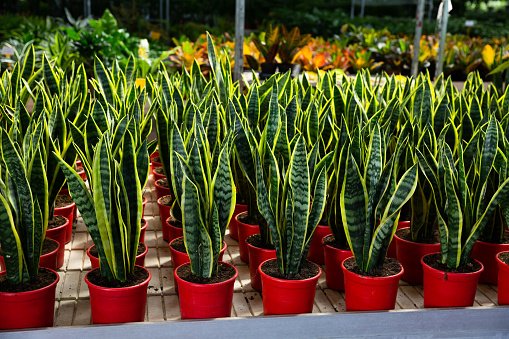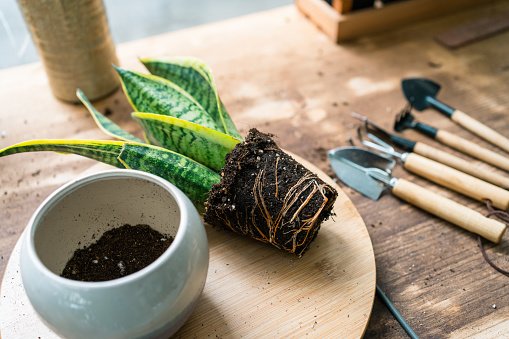
There is an evergreen thinking of many people that the laurenti snake plant can bring good luck for the plant owner. This concept has grown from the beneficial features like this plant can remove toxics. If you are a beginner, you are recommended to plant these laurentii snake plants.
When I started to have the laurentii snake plants in my house, I have felt an experience that these plants are a source of freshness. Like me, you will start realizing that there is a plant with long strong leaves with a yellow tip also. Meet the Laurentii Snake Plant, also known as Sansevieria Laurentii.
Simply, it knows how beautiful it is and this is a woman’s pride decor. It is not only a pretty bouquet of flowers, but it is also very hardy, easy to grow and very suitable for anyone who loves plants whether he is expert or new. Let’s know a clear and enjoyable discussion!
Types of Laurentii Snake Plant
Generally, laurentii Snake Plant is a subtype of the Snake Plant family or Mother-in-law tongue There are some prominent characteristic of these plants are sword leaves green in the heart with a yellow border, greenish body, etc.
While Laurentii is the popular name one of the snake plant families has got mother in law tongue plantar also. The snake plant family has other variants too. These come in variations of light green or dark. There are many such types which will surely enhance the beauty of the place. Let’s see some most common types of laurentii snake plants-
- Snake plant kirki
- Snake plant flame
- Snake plant futurs superba
- Snake plant bacularis
- Snake plant masoniana
- Snake plant black dragon, etc.
Laurentii Snake Plant Benefits
The Laurentii Snake Plant does not only look pretty, it is also a plant with multiple benefits. This plant generally cleans the room air by getting rid of harmful substances like formaldehyde and benzene. People know these plants as a natural air cleaner in the house. What’s more, it can also emit oxygen making the atmosphere breathable. In addition, it is said to enhance good luck and positive energies.
Let’s see what are the primary benefits of laurenti snake plant-
- Successful indoor air filtration system
- These plants can remove toxic pollutants from air
- Snake plants may help enhance mental health
- Very easy to take care which will reduce your efforts
- These are very effective against allergies
- Laurentii snake plants are a source of energy within a space
- These also help to minimize all minor ailments from air
Is Sansevieria Laurentii Poisonous?
Most importantly, as the Laurentii Snake Plant is beautiful and helpful, everyone should aware of the fact that it can be harmful also in some cases. These plants are poisonous if they are eaten by someone even by an animal. If it is eaten by pets or humans, they may experience nausea, vomiting, or diarrhea. So, it’s advisable to all to keep it away from the reach of inquisitive children and pets.
But good news is that, walking around and touching the plant won’t kill you. So, keeping some awareness will save you from different harms.
Planting and Taking Care of the Indoor and Outdoor Laurentii Snake Plant

The Laurentii Snake Plant is a beautiful plant with unique shaped leaves well-trimmed with yellow edges. It can be grown in pots both on a window sill and in a garden because it is extremely hardy and needs low maintenance. Below is how to plant and care for it in indoor and outdoor conditions-
- Indoor Care
Light Requirements: Ideal bright indirect lighting.
Tolerate: dark lighting but growth rate may be reduced.
Watering: First let the soil dry in between the two watering of the plant. Watering should be considerably less during the fall and winter. Do not over water; the plant has a tendency to get root rot.
Humidity: Although the indoors may be drier, snake plants companions are comfortable. – No need for extra adjustments for humidity levels.
Temperature: Happy with normal room temperatures of 15 to 29 degrees. There should be no temperatures below 10 degrees Celsius approximately 50 degrees Fahrenheit.
Soil: In case of planting, you have to use a potting soil which has good drainage properties like cactus or succulent mix. So, remember to use pots with drainage holes to prevent the roots from being waterlogged.
Fertilizing: Over-fertilizer plants as little as once a month early any other growing season like spring or summer with half-strength balanced liquid fertilizer.
Repotting: Repotting should be done after two as well as three years say on the year that the plant has out-grown its pot. The snake plant’s roots do rather well when they are slightly constricted.
- Outdoor Care
Light Requirements: It will be idle with half or full sun. The more light it gets, the more vivid its yellow edges will be.
Watering: Similar with house plants. Allow the soil to fully dry out in between watering. In hot dry regions, one must be very careful with this and watch the moisture but water less rather.
Soil: As for general care, snake plants do best outside when planted in a well-drained soil type that means sandy or loamy soil is ideal. Stay away from heavy pure clay soil types.
Temperature: Grow best outdoors in zones 9-11 where the temperature does not fall below 10 degrees centigrade and above 10 degrees centigrade. On the other hand, if growing in such regions one must take the plant inside during winter months.
Spacing: When planting, spacing varies among species but a distance of about 1 – 2 feet is advisable to allow for growth in case of planting outdoors.
Fertilizing: In spring and summer, when plants are in outside, apply a slow release granular fertilizer but do not apply fertilizer in autumn and winter.
How is the process of propagation and pruning of the Laurentii Snake Plant?

If there is a desire to get more of such indoor flowers made, it should be Laurentii Snake Plants? You are in luck! It is very easy to make more of them.
Propagation can be done by extracting the parent plant and planting its roots, or by slicing a leaf and putting it in water or soil so it can form roots on its own. In no time, you will have a complete family of snake plants! So, the propagation system of these snake plants is completely easy.
Again, pruning is the same way as it sounds. You can simply cut off the damaged or dried-out leaves cut off at the bottom. You will be impressed in the way that this practice improves the face of your plant.
Decorative Uses of Laurentii Snake Plant
Do you want to decorate your room with natural vibes? Then, this beautiful laurentii snake plant can be the best decorative item. Laurentii Snake Plant is practically living art. It includes sturdy and erect leaves which are best used in corners, halls or as the main item.
A modern pot would give a minimalistic appeal while a traditional pot would enhance warmth. Whether inside the house or outside, it beautifies the space.
Common Issues with Solutions during Planting

Despite being hardy, the Laurentii Snake Plant also has its some issues which are harmful. Yellowing leaves simply mean excess water usage. In that situation, water less and allow the land to dry.
Again, when the leaves are old and have changed in shape, this shows that they are dry, so you have to water them. Without proper watering and feeding, your plants may be paled.
Sometimes, spider webs may be found on plants which indicate the presence of spider mites. Just using a damp tissue to wipe off or spraying the plant with insecticide detergent will take care of this.
Conclusion
The laurentii Snake Plant is not only a decorative indoor plant; it is more hardy and lovely companion that can beautify the environment. Its attractive look, low maintenance nature, and how it thrives could be among the reasons why many lovers of plants have it.
However, this plant will impress the novice plant parent or an already experienced gardener as it is bound to put a smile on the user’s face every time they come across it. Have enjoyed these amazing snake plants!

